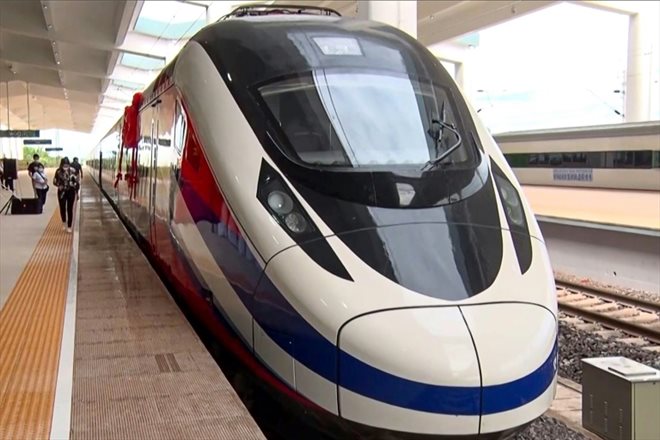Screen capture from Lao National TV, taken on October 16, 2021, showing Lao and Chinese officials gathered in Ventiane for the launch of the first railway line in Laos (LAO NATIONAL TV / AFP / Archives / STR)
Laos inaugurated with great fanfare in December an expensive railroad connecting it with China, but the party is likely to be short-lived, warn analysts, worried about the colossal Chinese loans that the poor Southeast Asian country will have to repay.
The long way connects the capital Vientiane to Kunming, in southern China. Grandiose plans include extending it to Singapore as part of a future regional high-speed network.
“The dreams of the Laotian people have come true,” congratulated President Thongloun Sisoulith at the December 3 inauguration, predicting “a new era of modern infrastructure development” for his isolated country.
His Chinese counterpart Xi Jinping even split a video appearance to present his congratulations, the project being financed by loans granted by Beijing as part of its “New Silk Roads” policy (“Belt and Road” ) launched in 2013 to increase its economic influence.
Analysts, for their part, fear serious repayment difficulties for Laos, whose debt now stands at $ 13.3 billion, or nearly three-quarters of its gross domestic product (GDP).
A situation likely to worsen the reputation of “satellite state of China” that drags the country, of which 47% of the debt is held by Beijing. The government hopes that the new railway line will become profitable by 2027.

Lao National TV screenshot, taken on October 16, 2021, showing the train of the first Laos railway line at Ventiane station (LAO NATIONAL TV / AFP / Archives / STR)
But connecting a small market of 7 million people to Kunming has “limited commercial logic for such an expensive railroad,” warns Jonathan Andrew Lande in a report for the Asian Development Bank.
Paying off the debt “will increase the pressure” on a government that already suffers from a “limited ability to raise taxes” due to the country’s poverty, he predicts.
– Unfavorable financial arrangement –
According to AidData, an institute of the American University William and Mary whose ambition is to make the financing of development in the world more transparent, the arrangement put in place to finance the project is proving unfavorable and risky for Laos.
The railway line is owned by a joint venture controlled 70% by three Chinese state-owned companies and 30% by a Laotian state-owned company.
Of the total cost of $ 5.9 billion, $ 3.54 billion was financed by loans from the Chinese bank Eximbank, and $ 2.36 billion by partners’ own funds.
But to provide its share of equity ($ 730 million), Laos signed an additional loan of $ 480 million from Eximbank. According to AidData, this arrangement amounts to a “hidden debt” which renders Laos’ share in the railway project “worthless”.
In addition, it remains to be seen which country would come to the aid of this structure in the event that it finds itself in default of payment, AidData highlighting the risk that Laos will be let go by its Chinese partners.

Lao National TV screenshot, taken on October 16, 2021, showing Lao Minister of Public Works and Transport Viengsavath Siphandone alongside Chinese Ambassador to Laos Jiang Zaidong (LAO NATIONAL TV / AFP / Archives / STR)
Communist authorities in Laos have long linked the country’s economic development to their powerful neighbor to the north. Between 2008 and 2019, Vientiane took out $ 5 billion in Chinese loans, mainly to finance dams.
In August 2020, the rating agency Moody’s relegated Laotian debt to the status of bad bonds, quickly followed by Fitch Ratings.
– At the edge of the fault –
According to AidData, the Laotian government was in early 2021 “on the verge of default and urgently requested relief from its debt to its Chinese creditors.”
But China is often reluctant to write off the debts of its creditors, and only grants them postponements (often accompanied by higher interest rates) or rescheduling.
In September, Laos sold its electricity distribution network to a Chinese state-owned company for $ 600 million, apparently to pay off some of its slate. Further sales of public goods are expected, Fitch said.
A phenomenon already observed in other Asian countries, the most striking case being the 2017 takeover by China of the port of Hambantota, in Sri Lanka, after the country was unable to repay a huge loan .
But for Ben Bland of the Lowy Institute, Laos has little choice. “What is the alternative?” Asks this researcher. “I do not believe that other investment and development partners want to supplant China.”
© 2021 AFP
Did you like this article ? Share it with your friends with the buttons below.




